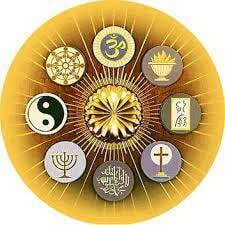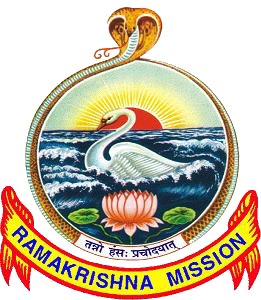
HINDU RELIGION AND SRI RAMAKRISHNA
HINDU RELIGION AND SRI RAMAKRISHNA
The One born as Rama of incomparable greatness in all the three worlds, the very life of Janaka’s daughter; who, though himself beyond the world lo, did not give up doing good to it; the current of whose love flowed ever unchecked down even to a Chandala; and whose body of supreme knowledge was enveloped by devotion in the form of Sita; the One born as Krishna, who sang the song (the Gita) sweet and tranquil, yet deep as the roar of a lion, suppressing the great cataclysmic tumult raised in the battlefield and destroying the innate profound darkness of ignorance— that ever-renowned divine personality is now born as Ramakrishna.1
The word Sastra denotes the beginningless and endless “Veda”. It is this Veda only that is capable of teaching religion.
The Puranas and other books are denoted by the word Smriti. They have authority only so far as they have followed the Veda.
“Truth” is of two kinds: (1) that which is perceivable by the five senses of human beings and is deducible therefrom by inference and (2) that which is perceivable by the subtle powers arising from Yoga.
The knowledge acquired by the first means is called science and that acquired by the second method is the Veda.
The beginningless and endless mass of infinite knowledge called the “Veda” is eternally existent. The Creator Himself is creating, maintaining and destroying this world with its help.
The person in whom that power of intuition is manifested is called a Rishi and the infinite knowledge that he comprehends through that power is called the “Veda”.
The attainment of this Rishi-hood, the seer-ship, of the immediate knowledge of the “Veda” is the true realization of religion. Until the aspirant’s life opens out to it, religion for him is a “mere meaningless word” and he cannot be said to have set his foot on the threshold of religion.
The authority of the Veda holds good irrespective of time, place and person; that is, its authority is not confined to a particular time, country or person.
The Veda alone sets forth the universal religion. Although a little of that infinite knowledge is to be found in the Itihasas, Puranas, etc., of our country and in the religious books of foreign countries, yet as the first complete and unaltered collection of the entire body of the eternal knowledge, the mass of words compiled into four books called the Veda, well known to the Aryans, is worthy of occupying the highest place in all respects, of being adored by the whole world and of being the ultimate proof of the truth of all scriptures, indigenous or alien.
Regarding the mass of words called the Veda, discovered by the Aryans, it must also be understood that that part alone of it which is not Arthavada1 (eulogy) or Aitihya2(tradition) or otherwise empirically known or knowable is the Veda. This mass of words is divided into two parts, namely, that relating to knowledge and that relates to work. As the rituals of the Veda and their results described in the “work” portion exist for all time in the domain of Maya, they are subject to transformation according to the law of change with reference to time, place, person, circumstances, etc. Yes, they have been and will be changed. As social manners and customs depend on this “work” portion, they also do and will undergo change. Similarly, popular customs and manners too have been
and will be accepted from time to time, only so far as they are not contrary to the scriptures and the conduct of the wise. One of the main causes of the downfall of the Aryans is their subjection to such popular customs and manners as are contrary to the Veda, to the conduct of the wise and to the scriptures conformable to the Veda.
The “knowledge” portion of the Veda, otherwise known as the Vedanta, — aided by selfless action, concentration of mind, devotion and self-knowledge — is eternally taking people across the ocean of Maya to the other shore of liberation. As it is not at all influenced by time, place and agency, it alone is the teacher of the universal religion—a religion that is meant for all peoples, all countries and all times.
It is on the basis of the “work” portion of the Veda that books on the social system by Manu and others have taught, in addition to other matters, those actions that are conducive to social- welfare, varying with time, place and agency; while books like the Puranas have taken up the truths hidden in the Vedanta and have explained them in detail by way of describing the great characters of the divine incarnations and others who are embodiments of one or other of the innumerable aspects of the Divinity, which these books try to emphasize.
But, in course of time, the descendants of the Aryans deviated from right conduct and, lacking dispassion, devoted themselves to the prevailing popular customs and grew feeble in intellect. They failed to understand the import of even the Puranas, which appeared as contradictory to one another on account of their teaching those different divine aspects and preaching the subtle truths of the Vedanta in gross and concrete forms in detail, for the consumption of weak brains. Hence, they split into numerous divisions the integral eternal religion, which is an aggregate of innumerable religious moods; and kindling the fire of sectarian hatred and jealousy, endeavored to throw one another into that fire. When they thus turned Bharata, the land of religion, almost into a hell, Bhagavan Sri Ramakrishna incarnated himself in order to show what the real religion of the Aryans was and where lay the unity amongst the numberless sects and denominations of the Hindu religion, scattered pell-mell over a vast range of time and place— the religion that has become a source of delusion to the people of the land and an object of hatred to those of other countries, owing to its apparent division into innumerable ever-warring sects bristling with contradictory customs. This he did by holding aloft before the gaze of all his own life as a living example of that religion eternal, by concentrating in himself its universality, lost by the lapse of time.
The Divine, whose embodiment the Veda is, almost wholly neglected literary education in this incarnation, in order to show how the eternally existing Sastra—with the help of which Isvara evolves, maintains and dissolves the universe—reveals itself in the heart of a Rishi wherefrom all Samskaras have been erased; so that, when the truth of the Sastras is thus proved, religion would be rediscovered and re-promulgated.
It is well known from such books as the Smritis1 that the Divine incarnates Himself again and again for the protection of the Veda, the true religion, and of Brahmana, the teacher of religion.
Even as a stream falling down a precipice gains in speed, and a wave rising after a fall swell higher, so after each downfall the Aryan society, shedding its morbidities, it is well known in history, emerges more glorious and vigorous under the compassionate guidance of the Divine.
Rising again after each fall, our society reveals more of the eternal perfection hidden within and the Divine, the internal controller of all beings, likewise manifests more and more His real nature in successive incarnations.
Again, and again did this land of Bharata faint away and again and again did its divine Lord manifest Himself and re-awaken it.
But in the past no new-moon night of sorrow veiled this holy land with such a profound darkness as the present one, though the night is all but gone, being now at the far end of its last quarter. However, the last fall of the country has been, as it were, to the bottom of the ocean, whereas, by comparison, all previous falls have been but the hoof-marks of a cow.
Therefore, compared with the splendor of this present awakening of Aryan society, previous awakenings will appear as lacking in luster like stars before the effulgence of the sun. And compared with the great vigor of this re-awakening, similar occurrences of the past will appear as child’s play.
On account of the lack of fit people to prevent the calamity, the fragments of the various aspects of the eternal religion lay scattered in all directions during the present downfall, in the form of petty sects. It was partially preserved in some places and utterly lost in others.
The most compassionate divine Lord has manifested Himself far more fully in this modern age, in the aforesaid form of the incarnation of the age, than He ever assumed in any other age, playing as He has done on the entire gamut of all the spiritual moods and experiences and utilizing to the utmost all arts and sciences.
In consequence of this fact, during this renascence, the descendants of Manu, invigorated by this new strength, will be able not only to piece together the fragmented and scattered mass of spiritual knowledge, but also to re-discover the lost branches of arts and sciences, and to enrich their lives by the realization of those ideas and ideals through proper understanding.
Hence is being preached the harmony of all noble ideas and ideals at the dawn of this great age. And this infinite and eternal grand ideal that lay embedded and hidden in the ancient scripture and religion of India is being loudly proclaimed in society.
This new faith of the age is the fruitful source of all blessings to the world, especially to India (Bharata); and Sri Bhagavan Ramakrishna, the founder of this new religion of the age, is the reformed manifestation of the ancient holy founders of the religions of the past. Have faith in it, O man, grasp it!
O man, a dead person never returns; a past night does not come back; an emotion, however passionate, never takes the same form over again; a Jiva, likewise, does not assume the same body twice. We, therefore, call you back from the worship of the past to that of the palpable present, from the useless expenditure of energy on regrets for the bygone to the grand endeavor of the living present; from the waste of energy in recovering lost pathways to the broad new-laid neighboring highways. Wise one, take the hint!
Imagine and feel the fully developed state of the power, the mere opening sound of which is reverberating in all the quarters to the very skies; give up all vain doubt, weakness, jealousy and malice common amongst a slave-race and help in the work of turning forward the wheel of this great age. We are the servants of the divine Lord, His children, His playmates, assisting Him in His play. Have this faith firmly implanted in your heart and come up to the field of action.
VIVEKANANDA
Footnote
1. The above is a translation of two Sanskrit stanzas composed by Swami Vivekananda. —Tr.
1. Vide Glossary. —Tr.
2. Vide Glossary. —Tr.
1. Books dealing with rules and regulations, governing society and religion. —Tr.




